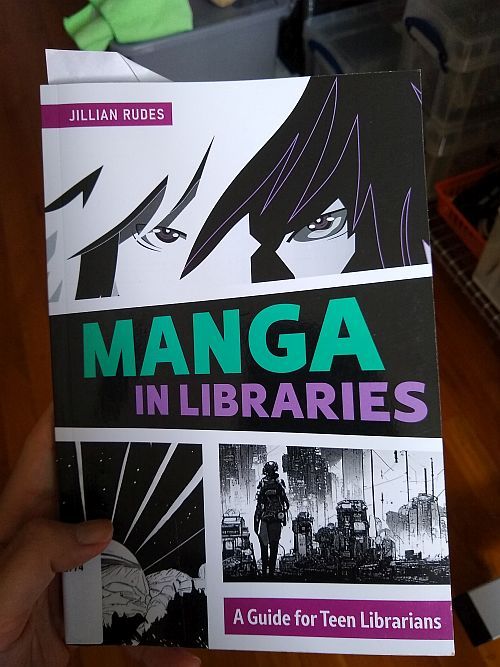For those who don’t know, I’m a fan of borrowing manga from my local library. I’m very thankful that I’m in a situation where my library has managed to hold off budget cuts every year. And more importantly, there’s some damn good librarians in New York City who care about manga. Around 2021, I found out about a librarian in my area specializing in Japanese pop culture who started a website curating information on how to advocate for manga in libraries. The librarian’s name was Jillian Rudes, who has gone on to do amazing things in the North American library scene for manga. She’s the founder of Manga in Libraries and earlier this year, she released a book for teen librarians called “Manga in Libraries: A Guide for Teen Librarians” on how to get started in promoting manga for educational purposes at their respective library branches.
I managed to borrow a copy from my library and I’ll say that it’s a solid resource.
At first, I was surprised at the size of the book (it’s about 130+ pages) because I was somewhat expecting a huge book due to reading various large books on manga over the years. Don’t be fooled though because there’s a lot of great information found carefully catered to the librarian and educator audiences. Jillian starts off by saying “Why Manga?” followed by a introduction to manga itself, how the text needs to be read, the various genres, U.S. publishers, etc.
The book is followed by chapters on developing a manga collection in a library, representation in manga, social-emotional learning, manga programming, and teaching in manga. Several interviews with notable manga experts are featured as well.
While every chapter is great, the strongest parts of the guide in my opinion are the chapters on social-emotional learning and teaching in manga. Jillian does an excellent job in explaining the core concepts of SEL and how they can be applied to libraries. She even discusses topics like emotional intelligence and the feelings wheel as well. Jillian makes a powerful case in how manga supports SEL using Komi Can’t Communicate as an example.
Jillian would later highlight Komi Can’t Communicate among other titles when she discusses how to use manga as a teaching tool in the classroom. She provides a template on how to go about creating a course on manga using her own experience in teaching manga to 12th graders at her school. It’s a very thorough one as Jillian explains specific activities she would incorporate to slowly get students engaged in learning through manga over a certain amount of weeks. The payoff is getting students REALLY involved in the teaching/learning process as they are told to create their own manga reading guides for the manga titles being discussed in their class.
As someone who doesn’t work in a library, I can only speak for the two chapters on SEL and teaching manga honestly because of my experiences and background in researching community-based initiatives for mental health. I’m all about thoughtful reflection with the help of peers and support systems outside of healthcare. I think Jillian does a wonderful job in explaining how manga can help in that area with those 2 chapters.
Reading the Manga in Libraries guide makes me glad that there are people who are trying to promote manga to teenagers in an educational manner. I think manga can change young lives for the better and I’ve seen it over time. Personally, I credit reading comics at a young age that got me on a journey to become a lifelong reader. I also like that the Manga in Libraries guide is in print because trying to find information on manga online can be a bit of a mess and very scattered. Jillian manages to condense a lot of resources in an easy-to-find manner for her guide.
Jillian makes a note in the end of the book that reading manga can create joy for those who read it. I believe it does for many people, especially teens who often feel out of place in the world we live in. And on that note, the Manga in Libraries guide is a joy that anyone interested in and/or advocating for manga education should not pass up on.
